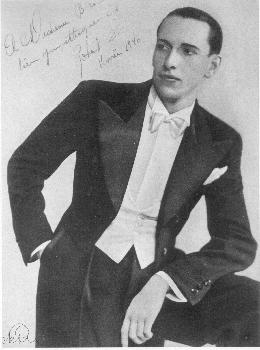Belgian tenor with primarily Belgian career, originally written Stény. He sang all over
the country: the earliest
references to him that I can find are from 1937 in Brussels, where he sang in Couchette no. 3, operetta by Szulc, in
February at the Théâtre de la Gaîté, and participated in the satirical revue Le roi, la loi, la
liberté in August at the Théâtre Molière. In 1939/40, he was in Liège, where he sang
Danilo in Die lustige Witwe (the above photo is from that production), Mireille and Les dragons de Villars.
In February 1941, he appeared in Frasquita in Namur.
In 1942, he was already a member of La Monnaie in Brussels, and toured the country with the troupe, singing not only at La
Monnaie proper, but also in Ghent, Antwerp, Tournai or Mouscron: Eisenstein, Sou-Chong, but also Massenet's des Grieux and,
remarkably, Tonio in La fille du régiment. Those performances took place between 1942 and 1945.
In 1946, he sang Almaviva with a prominent cast (Georges Villier as Figaro, Louis Musy as Bartolo, Louis Richard as Basilio, and
Joseph Rogatchewsky giving a short concert during intermission!!) at the Théâtre Royal du Parc in Brussels in June,
and concerts with excerpts from Lakmé and Madama Butterfly, respectively, in Oostende in
July. In June in Brussels, he was still advertised as a member of La Monnaie; in July in Oostende, as a member of the
Gaîté-Lyrique in Paris.
In 1949, he sang twice in Tours: Alfredo in November, Almaviva in December. In November 1951, Die lustige Witwe in Geneva,
now as Camille de Rosillon.
Reference 1: Het Nieuw Visscherijblad, 12 July 1946; reference 2;
reference 3;
reference 4: archives of the Geneva opera theater; reference 5: Honoré Lejeune, Bruxelles-Théâtres 37,
Verviers 1938
